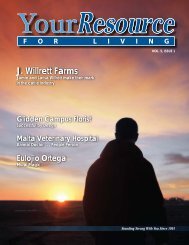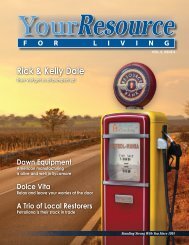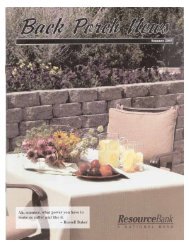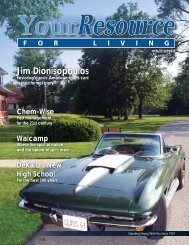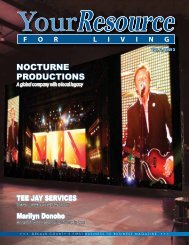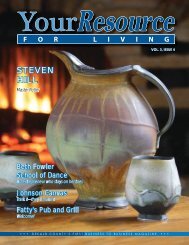Create successful ePaper yourself
Turn your PDF publications into a flip-book with our unique Google optimized e-Paper software.
CRAFTSMAN<br />
24<br />
24<br />
when his uncle<br />
passed away—still too<br />
young to take over the sizeable<br />
painting company. Once again, the path<br />
he might have followed came to an abrupt<br />
end, but as they say, when doors close,<br />
windows open.<br />
Even while working with his uncle <strong>and</strong><br />
attending Washburne, Roger had been<br />
commuting back <strong>and</strong> forth to DeKalb to<br />
attend a few classes at NIU <strong>and</strong> to pick up the<br />
occasional painting job to help pay for tuition.<br />
When he turned twenty-one <strong>and</strong> was free to<br />
blaze his own trail in life, he decided to strike<br />
out <strong>and</strong> start his own painting company in the<br />
college town west of Chicago. It was 1973.<br />
In DeKalb, Roger married, <strong>and</strong> he <strong>and</strong> his<br />
wife, Mary, soon had a family to support,<br />
but Roger was nevertheless discriminating<br />
about the work he took on. “I tried to work<br />
whenever I could on houses that were either<br />
on the historical register or could be.” This<br />
penchant for historical restoration, inspired<br />
by the years he spent working with his<br />
uncle, led Roger to volunteer to restore the<br />
little playhouse that now sits behind the<br />
Elwood House on First Street. It wasn’t a<br />
paying job, but it was a mission he could put<br />
his heart into.<br />
“It’s still one of my favorite projects, <strong>and</strong><br />
I learned a lot about the little house’s<br />
history while I was working on it,“ Roger<br />
remembers. “Not many people know that<br />
it was originally constructed in 1891 as a<br />
parade fl oat for a local shoe factory. I also<br />
discovered that the spindles on the porch<br />
rail were originally created by shop students.<br />
Every spindle was unique, so I took a lot<br />
of care to retain the character of each one<br />
during restoration.” Roger fondly recalls<br />
another reason the playhouse has a special<br />
place in his heart: “My daughter, Meghan,<br />
<strong>and</strong> my son, Matt, played in the house while I<br />
worked on it. That was a lean year, fi nancially,<br />
but I have a lot of good memories.”<br />
Over time, Roger’s interest in historical<br />
restoration began to position him as project<br />
manager for many of the jobs he took on. “I started<br />
out as a painter, but a lot of the work I did required me<br />
to take architectural elements apart <strong>and</strong> reassemble<br />
them, or to entirely reconstruct something that had<br />
been destroyed or neglected beyond repair. I couldn’t<br />
always fi nd a carpenter who was willing or able to<br />
deal with saving old construction when it was just<br />
easier to build something new. So I learned a lot about<br />
carpentry. Once you start doing that kind of work, you<br />
just naturally start to underst<strong>and</strong> the larger picture. ”<br />
A natural detective when it comes to fi guring out how a<br />
building had been constructed, even a century or more<br />
ago, Roger became a resource for the other tradesmen<br />
he worked with. “I do a lot of research when I take on<br />
a historically sensitive project. Kind of by default, I<br />
became the guy the plumber or the electrician or the<br />
carpenter would come to when they had a question<br />
about the most appropriate way to do something.”<br />
While Roger manages a good number of the projects<br />
he is involved in, he is quick to acknowledge that<br />
historical restoration is a collaborative enterprise<br />
<strong>and</strong> that he is often one among many specialists<br />
working on a job. “Whether <strong>RW</strong> <strong>Keys</strong> <strong>and</strong> <strong>Son</strong> is called<br />
in as consultant, general contractor, or a specialist<br />
in painting <strong>and</strong> window restoration, we’re always<br />
learning something from the other people on the job.<br />
For example, we’ve worked closely on a number of<br />
jobs with Bill Schermerhorn. Bill owns Ornamental<br />
Plaster in Rochelle, <strong>and</strong> he helped us restore capitals<br />
on some of the columns in the old Carson, Pirie, Scott<br />
building, which was designed by Louis Sullivan. Some<br />
of the capitals had to be reconstructed <strong>and</strong> reinstalled,<br />
<strong>and</strong> we discovered that the techniques they used in<br />
1899 are just as workable today.”<br />
<strong>RW</strong> <strong>Keys</strong> <strong>and</strong> <strong>Son</strong>? “That’s right,” Rogers says,<br />
smiling. “Matt went to work with me about fi fteen<br />
years ago, <strong>and</strong> he’s earned his place in the company.”



